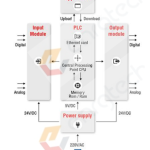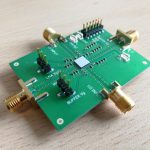
WiFi 6, also known as 802.11ax, is the latest version of the popular wireless networking technology. It offers significant speed improvements, network performance, range, and reliability over its predecessor, WiFi 5 (802.11ac). It has a great range of consumer benefits, offering crucial advantages for enterprise IoT applications. The Internet of Things (IoT) is the expanding and growing network of physical devices, vehicles, and other items embedded with software, sensors, and other technologies, enabling them to connect and exchange data with other systems and devices over the Internet. IoT is rapidly transforming many industries, including healthcare, manufacturing, transportation, and more. However, these applications require robust and reliable connectivity for effective functionality, and this is where WiFi 6 plays a role.
Wifi 6 Operation and Technologies
Wi-Fi 6, operating on both the 2.4GHz and 5GHz frequency bands, uses a variety of new technologies to improve the wireless experience, such as:
- Orthogonal Frequency Division Multiple Access (OFDMA) allows multiple devices to share the same channel simultaneously, increasing network efficiency.
- Multi-User Multiple Input Multiple Output (MU-MIMO) enables multiple devices to communicate with the router at the same time, thus improving throughput and reducing latency.
- Target Wake Time (TWT) enables devices to conserve battery power by scheduling their Wi-Fi usage.
Wifi 6 for Enterprise IoT Applications: The Benefits
It offers several benefits for enterprise IoT applications, where some of the key benefits include the following:
WiFi 6 Faster Data Transfer Speeds
One of the prominent advantages of WiFi 6 is its ability to provide faster data transfer speeds. It can support data transfer with increased speed rates of up to 9.6 Gbps, nearly three times faster than WiFi 5. This is particularly important for IoT applications, especially where quick and reliable transmission of large amounts of data is required between devices and systems.
For example, in a healthcare setting, WiFi 6 could enable medical devices to quickly and securely transmit patient data to electronic health records (EHRs). This allows doctors and nurses to make faster and more informed decisions about patient care. In a manufacturing environment, WiFi 6 could enable sensors and other IoT devices to quickly communicate with each other and central systems, allowing for real-time monitoring and analysis of production processes.
Improved Range and Coverage
Another significant advantage of WiFi 6 is its improved range and coverage. It uses a new technology called Orthogonal Frequency Division Multiple Access (OFDMA). Which not only increases the network’s overall capacity but also improves the range and coverage of the signal, making it more reliable and consistent.
This is particularly important for enterprise IoT applications, where devices may be in remote or hard-to-reach areas. These devices can still be connected to the network, even if they are distant from the access point.
WiFi 6 Enhanced Reliability
The beamforming and MU-MIMO features of WiFi 6 improve the reliability and quality of wireless connections. This is typically achieved by directing signals to specific devices and reducing interference from other devices.
Better Performance in High-Density Environments
One of the challenges of traditional WiFi networks is that they struggle to perform in high-density environments, such as airports, stadiums, or large office buildings. The reason is that too many devices compete for the same limited bandwidth, thus leading to slow speeds and poor connectivity.
These addresses this issue by using a new technology called Multi-User Multiple Input Multiple Output (MU-MIMO). Which is particularly beneficial for enterprise IoT applications, where many devices may need to be connected to the network at once.
Enhanced Security Features
Enhanced security features are another advantage of WiFi 6 for enterprise IoT applications. It includes several new security protocols, such as WPA3 and Enhanced Open, providing stronger encryption and authentication mechanisms. These protocols protect against hacking and other cyber threats.
Furthermore, this is especially important for IoT applications, which often involve sensitive data and critical systems. With WiFi 6, enterprises can ensure that their IoT devices and networks are secure and protected from potential security breaches.
The Final Words
WiFi 6 offers numerous benefits for enterprise IoT applications, including faster data transfer speeds, improved range and coverage, better power efficiency, better performance in high-density environments, high reliability, and enhanced security features. Bespoke technology also provides a significant advantage in terms of managing the increasing number of connected devices and data traffic. As more enterprises adopt IoT technologies to improve their operations and services. It will play an increasingly important role in ensuring that these systems are reliable, secure, and high performing.





















